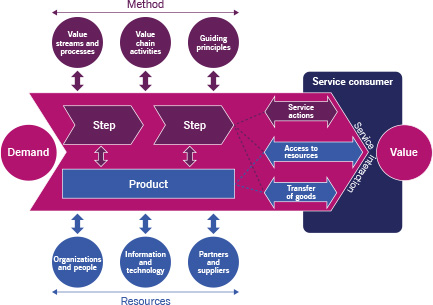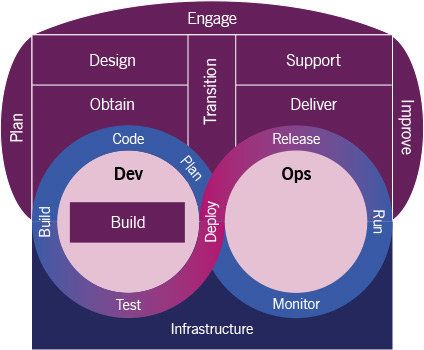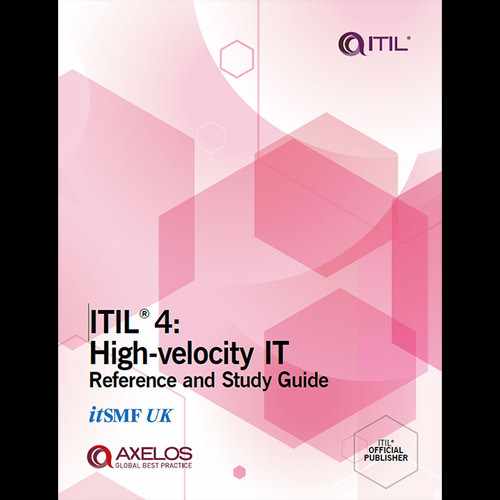3 High-velocity IT across the ITIL model
3.1 Four dimensions of service management
The four dimensions of service management identify the kinds of resources that are used in a value stream. Three of the four dimensions (organizations and people, information and technology, and partners and suppliers) are concrete resources that are used operationally during the execution of the value stream steps. The value streams and processes dimension represents abstract resources that are used as input for the design of value streams. This is shown in Figure 3.1.

Figure 3.1 The value stream in context
Examples of the application of each dimension to HVIT are described in the following sections.
3.1.1 Organizations and people
In HVIT environments, where IT is an integral part of an organization’s products and services, it is likely that the IT function will be an integral part of the lines of business that are responsible for the various products and services. There will often be multifunctional product/ service-based teams, with both business-oriented and IT-oriented team members. Although there may be a centralized IT service centre for non-differentiating digital technology such as email and Wi-Fi, the differentiating digital technology will often be managed as part of the primary activities. There may also be platform-oriented teams that support various decentralized product/service-based teams.
3.1.2 Information and technology
In HVIT environments that derive significant value from digital technology, part of this value is related to the information that the digital systems provide, and part is related to the digital technology that provides the information quickly, resiliently, securely, and efficiently. Higher demands are therefore placed on both the information and technology that digitally enable organizations, and the information and technology (IT tooling) that support the IT processes. An example of HVIT tooling is an automated deployment pipeline that ships new versions of applications faster and more reliably to production.
HVIT environments typically make extensive use of cloud-based infrastructures, platforms, and other services. These utility services are often provided by organizations on their own terms and conditions. Public cloud-based services are usually high quality and affordable, but the individual consumer has little or no influence on the provider. It is therefore crucial to analyse the dependencies and take appropriate action in terms of contracts and service level agreements (SLAs), including risk-sharing agreements, secondary providers and contingency plans, and workarounds.
When outsourcing work in an HVIT environment, it is important to consider whether the external service provider works in a similar way to its customer, as it is difficult to integrate parties with fundamentally different ways of working into the same value stream. Functional outsourcing, in which discrete functions, such as testing, are outsourced, is often less effective than outsourcing a whole value stream.
3.1.4 Value streams and processes
HVIT environments recognize that it may be better to create a unique value stream for each digital product or service. This may be less efficient than a standardized and centralized single value stream that serves multiple products and services, but the benefits in terms of effectiveness will often outweigh the costs, so it is advisable to consider this alternative.
HVIT environments often deal with complex systems that are unpredictable, so the use of processes should be reserved for those situations where it is feasible to predetermine the appropriate sequence of activities. Practitioners will often think in terms of various patterns of activities that might work, and will experiment to select the right patterns for the task at hand.
3.1.5 External (PESTLE) factors
An organization’s choices of markets, products and services, and resources and activities are influenced by multiple external factors, which can be political, economic, social, technological, legal, and environmental (PESTLE). These all influence the four dimensions of service management.
HVIT environments are also characterized by relatively high degrees of volatility, uncertainty, complexity, and ambiguity, which are referred to by the acronym ‘VUCA’. VUCA presents a serious managerial challenge, and should be considered in the planning and management of organizations.
An organization that experiences VUCA to a greater degree will typically pursue more evolutionary approaches, based on an assessment of the disposition of the actors in the external and internal environment, and experimentation with the factors that influence those actors. In these organizations, the focus is more on managing the present, rather than making and following a roadmap to a predetermined future state.

Exam tip
It should be noted that there is some overlap between assessment criteria 2.1(b) and 2.1(c): both refer to the service value chain (section 3.3), the service consumer (section 3.3.3), and value streams (section 3.3.1). The content has not been duplicated for these topics, so the reader should read section 3.3 with both assessment criteria in mind (see Table 8.1 for the assessment criteria in the HVIT exam).
It should also be noted that the service value system comprises topics that are described in other sections of this publication. They are the ITIL guiding principles (section 4.2.4 non-examinable), the ITIL practices (sections 5.2, 5.4, 5.6, 5.8, and 5.10), the service value chain (section 3.3), and continual improvement (section 4.2.3.3 (OODA loop, non-examinable)).
HVIT aligns high-value IT-related work with high-velocity business, from innovation to value realization. This requires fast flow, fast feedback, and fast improvement, and not only results in things getting done faster but also improves the quality of IT-related products and services. This has significant implications for organizational IT operating models. Digitally enabled organizations define and structure their IT-related activities and resources differently from organizations in which IT is of less strategic significance. The higher demands that digitally enabled organizations place on technology are reflected in the way they operate.
This section illustrates how ITIL guidance can be used to provide building blocks for an IT operating model that defines HVIT work and its organization.
An operating model is the ‘back end’ of an organization’s business model, and delivers the value propositions defined in that business model. The operating model is a representation of the building blocks of an organization and the relationships between them. It can be used as a description of the current state of the organization, or as a future state design, referred to as a ‘target operating model’.

Definitions
• Operating model A conceptual and/or visual representation of how an organization co-creates value with its customers and other stakeholders, as well as how the organization runs itself.
• High-velocity IT operating model An IT operating model where digital technology plays a major role in the co-creation of value.
A high-velocity approach is typically required for an operating model when there is co-creation of value with customers, when operating models are becoming significantly more digital, or in response to uncertain, ambiguous, and rapidly changing circumstances. There is often as much value, if not more, in the process of creating the operating model as in the end product.
An HVIT operating model is one in which digital technology plays a major role in the co-creation of value. All operating models have some digital elements, but a digital operating model is one where digital technology makes possible a model that is otherwise not feasible or practical without it.
Operating models for digitally enabled organizations are characterized by their focus on:
• dedicated value streams for each of their products and services
• a co-creational culture that fosters high performance and continual improvement
• permanent product/service-based teams over temporary project teams
• automation of IT processes, including infrastructure as code (IaC).
In ITIL, value streams are at the core of the operating model because they are the sets of steps required to deliver products and services. HVIT can be supported by many elements of the ITIL service value system (see Figure 3.2).

Figure 3.2 The ITIL service value system
3.2.2 Governance and management ![]()
Governance is the means by which an organization is directed and controlled. The governing body evaluates the organization’s situation, sets the direction for managers, and monitors the organization’s performance. Management is anchored in governance. Managers deal with planning, building, organizing, and improving the organizational entity.
Responsibility for digital technology is an integral part of the lines of digital business in digitally enabled organizations, and is not a separate unit such as a centralized IT service centre (although these may exist for non-differentiating IT services, such as email). The governed and managed organizational entity is therefore responsible for both digital technology and its use in the context of digital products and services.
Practitioners operate within a governance and management framework. They understand the applicable constraints and know how to act within that framework, and their insight and judgement influence how they act.
The more insight they have, and the better their judgement skills, the more the practitioner will take the initiative to bend rules when the associated benefits and risks are justifiable. This can be very beneficial, as HVIT environments are often highly unpredictable, meaning that predetermined instructions are neither feasible nor desirable.
An HVIT practitioner therefore has to exercise judgement on the job. To do this effectively, they must understand the reasoning behind certain constraints that are in place. A major role of the manager in an HVIT environment is therefore to provide context and to enable the practitioner to take charge.
The ITIL service value chain is useful for describing, at a fairly high level of abstraction, the types of activities that a service provider executes (see Figure 3.3). It helps people to focus on the goal of each value chain activity, and the inputs and outputs, without getting lost in the details of the lower-level activities in a value stream.

Figure 3.3 The ITIL service value chain
The value chain activities are closely interrelated, and can be arranged in any order to explain and discuss a range of different situations.
A value stream is a series of steps an organization undertakes to create products and services and deliver them to consumers. They are sets of activities that are performed according to guidelines (principles, approaches, techniques, etc.) and within constraints (regulations, policies, budgets, etc.).
This is depicted in Figure 3.1, in a value stream that is triggered by demand for value, which is co-created using products and services.The value stream consists of steps in which resources are combined, resulting in products designed to enable value creation, not only for the service consumer but also for other stakeholders. Activities performed by the resources are guided by various methods adopted by the organization (descriptions of value streams and processes/procedures/ work instructions in the practices, descriptions of the activities in the service value chain, and the guiding principles).
The activities that are required to deliver products and services are modelled by the organization’s service value chain and practices. The service value chain describes the organization’s archetypal activities (see Figure 3.3).
The service value chain describes the activities that are required to effectively manage products and services, whereas a value stream comprises an actual series of steps to create products and services and deliver them to consumers. As such, value streams can be considered to be where things actually happen: where the ITIL practices are used and value is co-created. There is no set structure for value streams, and they are unique to each organization. HVIT organizations are often product/service-oriented and have multiple value streams that reflect the diversity of their products and services. Their operating models therefore comprise multiple value streams.
It is also important to get feedback as quickly as possible, not only to make any improvements that may be needed but, crucially in a volatile HVIT environment, also to evaluate whether the way of working or way of thinking needs to be improved. In these dynamic environments, the improvement of daily work is as important as actually doing daily work.
In HVIT environments, systems are often complex and therefore unpredictable. This makes it less likely that detailed processes, procedures, and work instructions will be useful, as often they will not be followed. It is also not useful or feasible to predict or dictate the sequence of steps in a value stream, and the activities within those steps, other than at a high level of abstraction. Instead, the sequence of activities and steps will often emerge during, and as a result of, the ‘micro-interactions’ that take place during execution. This means practitioners must be able to observe the expected and unexpected changes that their actions, and those of others, make, and adjust their next actions accordingly.
3.3.2 Service value chain activities and DevOps
In HVIT environments, the concept of ‘continuous’ is often used, and is a key characteristic of many HVIT approaches. ‘Continuous’ refers to fast, iterative cycles of activities, enabled by short feedback loops. CI/CD (continuous integration, continuous delivery, and continuous deployment) is a well-known example of this, as used by the DevOps community.
Figure 3.4 shows how the DevOps activities (in the loop) and the service value chain activities can be combined. Some service value chain activities (such as design and transition) have been split into two ‘sub-activities’ that are easier to map to parts of the DevOps model.

Figure 3.4 DevOps and the service value chain
In ITIL terminology, DevOps focuses on developing, deploying, and running concrete service components rather than intangible services. The dominant service components in DevOps are the applications, data, and platforms that together form a product for the consumer. The focus of the service value chain is on products and services rather than individual service components. It describes what is needed for the interaction between the service provider’s products and other resources, including the service consumer’s resources.
Another way that HVIT can be applied to the service value chain is in illustrating how closely service providers and service consumers interact. A service consumer regards the high-level interaction with a service provider in terms of acquisition, provision, and use. The consumer translates their demand into requirements, and engages a provider to provide services that they then use to create value.
Figure 3.5 shows the six value chain activities of the service provider, with initial design and transition, and obtain/build in the top half, and deliver and support (in parallel with subsequent enhancement) in the bottom part. The primary interfaces between the consumer and provider are marked by the consumer’s requirements (R) and the provider’s service (S). Design and development, and deliver and support are connected by the product (P) that is deployed.

Figure 3.5 An example of a value stream referring to service value chain activities
Figure 3.5 also shows how a value stream can flow across the value chain activities. It is important to recognize that the service value chain and associated practices are models on which actual value streams are based. Value streams can be observed where people and other resources act to co-create value. Service value chains and associated practices cannot be observed, as they are abstract representations that are used to model the value streams.
3.4 Digital product lifecycles
Service consumers and service providers have different perspectives on digital products. They each have their own product lifecycles, which overlap during the period of engagement between the consumer and provider. For the service provider, the lifecycle of a product lasts for as long as there are potential customers for that product. For the service consumer, the lifecycle continues for as long as the product is used, and strictly speaking is a product use lifecycle.
Table 3.1 outlines the lifecycle stages of a digital product from the perspective of the service provider and service consumer.
Table 3.1 Stages of the digital product lifecycle
Lifecycle stage |
Service provider |
Service consumer |
Exploration |
The service provider researches and develops the product and service offering. |
The service consumer becomes aware of the existence of a product and assesses it as interesting and then desirable, after which an agreement is made. |
Onboarding |
An instance of the product is installed, and the user organization is onboarded, sometimes with a transition from a replaced product. |
|
Co-creating value |
The service provider delivers and supports the product and experiences increasing, stable, or decreasing return on investment, leading to an investment decision to buy (use and improve the product), hold (use but do not improve it), or sell (use and reduce, replace, or retire it). |
The service consumer uses the product and experiences increasing, stable, or decreasing value, eventually leading to a decision to replace or retire the product. |
Offboarding |
The instance of the product is uninstalled and the user organization is offboarded, sometimes with a transition to a replacement product. |
|
Retired |
The service provider no longer offers or supports the product. |
The service consumer no longer uses this product, but other consumers may use it. |
